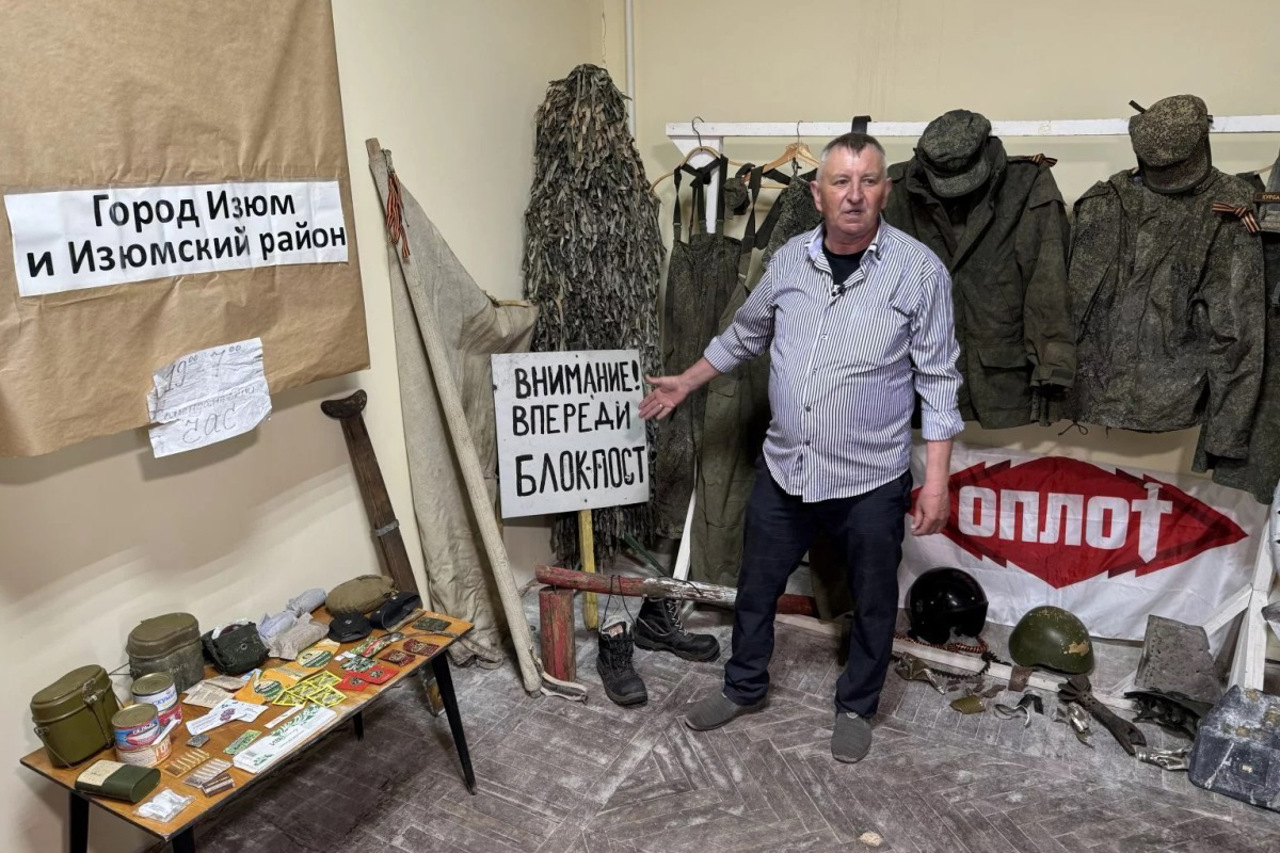In the year and a half that passed after the liberation of the city, residents of the Izium community collected two hundred items related to the Russian occupation.
Kostiantyn Hryhorenko, the publisher of the newspaper "Obriyi Iziumshchyny" is creating a museum of occupation in Izium, Kharkiv Region, where residents bring propaganda leaflets and newspapers, sukhpai, chevrons and personal belongings of the occupiers. Radio "Nakypilo" reports this.
The purpose of creating the museum is to document and collect the evidence base of war crimes of the Russian Federation in order to prevent the aggressor from lying with impunity about the "civil conflict" or hired actors.
The museum collection already has more than 200 artifacts.
"We made the first announcement in the newspaper and called on people to bring artifacts that they kept at home. Because they [Russians] lived in many of them - simply in their houses, homes. And people suffered a little bit. At first they were afraid to disclose, they asked on the condition of anonymity , and we treated it with understanding," Hryhorenko says about the creation of the museum.
A local resident, who survived the occupation and even interrogations by Kadyrov and the FSB, brought to the museum's collection soldier's tins-bottles, canned goods, sugar and matches with Russian markings. Also among the exhibits is a road sign with the Latin "P", which usually indicates a parking lot, which the Russians somewhere removed and wrote on the reverse side: "Caution, roadblock ahead."
The museum also keeps the flag brought to Izyum by Zakhar Prilepin, a Russian propagandist writer and participant in the hostilities against the Ukrainian army.
Konstantin says that he read Prilepin's telegram channel to learn about the events in Izium. The propagandist actively posted messages about local collaborators, directly with names, photos, videos - which later became confirmations of cooperation with the occupiers.
The collection also includes several Russian uniforms, worn shoes, helmets and ear-flaps, the newspaper "Krasnaya Zvezda", a leaflet of the Russian Ministry of Defense and almost all issues of the publication "Kharkiv Z", which was printed in Belgorod.
Maksym Strelnyk, deputy head of the Izium MBA, also supported the idea of creating a museum.
"This is also very important in the process of renaming. You know that in Izium all toponyms that had communist names and Russianisms were renamed. Now there is not a single toponym in our city that is in any way connected with the aggressor country Russia," he said he.
Hryhorenko will later hand over all the exhibits to the balance of the Izium Museum of Local Lore. The museum building was also damaged - two hits, but all the exhibits managed to be taken out undamaged.
Photo: nakipelo.ua
Видавець газети "Обрії Ізюмщини" Костянтин Григоренко створює в Ізюмі на Харківщині музей окупації, куди мешканці приносять агітаційні листівки та газети, сухпаї, шеврони й особисті речі окупантів. Про це повідомляє радіо "Накипіло".
Метою створення музею є документування і збір бази доказів воєнних злочинів РФ, щоб не дати агресору безкарно брехати про "громадянський конфлікт" або найнятих акторів.
У колекції музею вже понад 200 артефактів.
"Ми зробили перше оголошення в газеті і закликали людей принести артефакти, які вони зберігали у себе вдома. Тому що вони [росіяни] жили у багатьох – просто в їхніх будинках, оселях. І люди потрошку понесли. Спочатку боялися розкривати, просили на умовах анонімності, і ми з розумінням до цього ставилися", – розповідає про створення музею Григоренко.
Місцевий мешканець, який пережив окупацію та навіть допити кадирівців та ФСБ, приніс у колекцію музею солдатські жестянки-пляшки, консерви, цукор та сірники з російським маркуванням. Також серед експонатів є дорожній знак із латинською Р, що їм зазвичай позначають парковку, який росіяни десь зняли й на зворотному боці написали: "Внимание, впереди блокпост".
Також у музеї зберігається прапор, який привіз до Ізюма російський письменник-пропагандист, учасник бойових дій проти армії України Захар Прилєпін.
Костянтин розповідає, що читав телеграм-канал Прилєпіна, щоб дізнаватися про події в Ізюмі. Пропагандист активно постив повідомлення про місцевих колаборантів, прямо з прізвищами, фото, відео, – які потім і стали підтвердженнями співпраці з окупантами.
Колекція містить і кілька російських одностроїв, ношене взуття, шоломи та шапки-ушанки, газету "Красная звезда", агітку російського міноборони та майже всі випуски видання "Харьков Z", яке друкувалося в Білгороді.
Підтримав ідею створення музею й заступник начальника Ізюмської МВА Максим Стрельник.
"Це дуже важливо і в процесі перейменування. Ви знаєте, що в Ізюмі були перейменовані всі топоніми, які мали комуністичні назви та русизми. Зараз у нашому місті немає жодного топоніма, який би був якимось чином повʼязаний з країною-агресоркою Росією", – сказав він.
Усі експонати Григоренко згодом передасть на баланс Ізюмського краєзнавчого музею імені Миколи Сібільова. Будівля музею теж постраждала – два влучання, але всі експонати встигли вивезти неушкодженими.
Фото: nakipelo.ua



